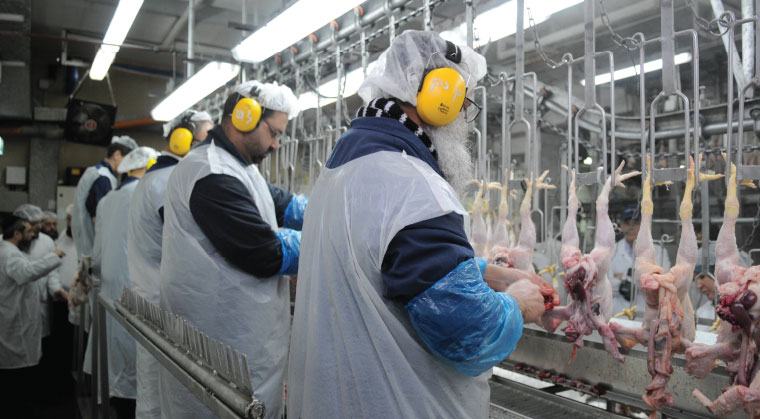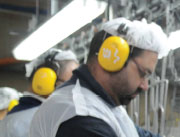Israeli Shochtim Cry Foul


Photo: Flash90
While Israel has taken action in recent years to increase safety measures in other industries the government has yet to enact standards in the slaughterhouse where shochtim stand side by side often in crowded conditions sharpened knives in hand.
“In the poultry-slaughtering industry there is no supervision no regulation and no procedures in place in case of accidents” says Sabi Amar chairman of the Shochtim Association at the Milo’of factory in Acco. “This is a matter of life and death and we have to make sure to deal with it before it’s too late.”
Amar says the government has never provided clear guidelines for a safe amount of space between ritual slaughterers. “It’s enough for the knife of the shochet next to you to slip a bit too far and you can be injured” he says. “That’s also the reason there are very few shochtim who don’t bear scars of injuries some worse some less.”
At the factory where he works he says the company recently added two shochtim to stand on a ramp that already included 12 slaughterers. He has contacted the Economy Ministry to complain about workplace conditions but so far they have done nothing to address his concerns.
According to halachah a shochet needs to do his job calmly Amar says “but when you are always under pressure about what is behind or ahead of you there’s no way you can concentrate on the slaughter because you’re afraid of getting hurt.”
According to a spokesperson for the Economy Ministry shochtim are protected by “various means such as protective gloves with long sleeves that protect against sharp objects.” The Ministry further said that any halachic guidelines regarding shechitah are not under their purview.
The Agriculture Ministry likewise says that worker safety is not under its authority. “If it would be a matter of damage to the chickens we would be dealing with it but regarding the chareidi shochtim — they are not under our purview and we have no responsibility toward them.”
Daniel Bar a spokesman for the Chief Rabbinate also says his ministry has no authority in worker safety. “But we will look into the matter [of worker safety]” he told Mishpacha “and if we believe that there is a specific problem in the area of safety in shechitah we will contact the relevant ministry to examine the introduction of legislation to ameliorate the matter.”
Amar isn’t the only one who’s concerned about worker safety. Itamar Firchi of the Power for Workers organization which works with the Association for Poultry Slaughterers said enough isn’t being done to protect workers from harm.
“Over the past few years that we have been accompanying kosher shechitah in Israel we have encountered dozens of work accidents relating to the profession that stem from improper work settings lack of safety regulations lack of guidance of oversight or from insufficient equipment or supplies. The number of accidents and the insufficient responses we receive from employers have led us to the understanding that the entity in charge [the Economy Ministry] is the only one that can bring about the necessary change in the industry and thus we demand its intervention immediately.”

Photo: Flash90
Veterinarians working in the same slaughterhouses are regulated by the Agriculture Ministry. One such regulation stipulates that veterinarians must work at least one meter from one another. And if the veterinarian is a supervisor he or she is entitled to a one and a half meters of space.
In addition to safety concerns shochtim say they’re being shortchanged if and when they’re injured on the job. They claim that when they apply for compensation for workplace accidents however they do not always receive payments from the National Insurance Institute.
Take Motty for example: He is a shochet who works in a factory in the south of Israel who lost part of a finger during a poultry slaughter just last week. He says he’s currently on sick leave and hopes that he’ll get payments in full from the NII.
“But I’m not optimistic” he concedes “because of my friends’ failed efforts. Many of them complained about cuts back and joint problems that stem from their work but in almost no case did they receive any NII money.”
Sabi Amar notes that among his friends there are many similar complaints. He points out that chickens have almost doubled in weight in recent years and as a result there are more injuries especially infections of the thumb and left shoulder which bear the weight of the bird.
“Nevertheless” he says “I know that those who applied for compensation from the NII did not receive it even though workers in other industries receive payments for illnesses or injuries caused directly by their work.”
Moshe Berger spokesman for the NII said that a shochet injured during the course of his work should be entitled to a stipend for work injuries but each case is examined separately.
Oops! We could not locate your form.












